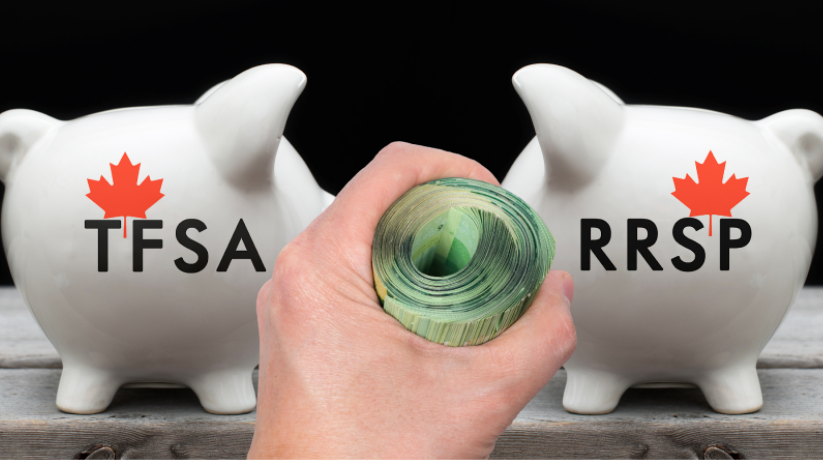
Is It Better to Put Money into an RRSP or a TFSA?
Ideally, we should all put money in both TFSAs and RRSPs. However, many of us have to choose how we save our money.
Both accounts offer tax benefits while helping you save for the future, build a financial nest egg, and reach your financial goals.
While they have many similarities, the RRSP and TFSA are also different. The big difference between the RRSP and TFSA is how they are taxed.
If you want to decide where to put your money, it is vital to understand how RRSPs and TFSAs work and fit into your financial situation.
What is the RRSP?
An RRSP is a tax-deferred account, also known as a Registered Retirement Savings Plan.
When you contribute a portion of your income to this type of account, you do not pay taxes on that income in the current year. Instead, you defer your taxes to the future, which means that you will be taxed on this when you withdraw money from your RRSP after you retire.
How much you can contribute to your RRSP depends on your income for the year. Generally, you can contribute up to 18% of your income in a year. For example, if you earn $60,000 this year, you will be able to contribute $10,800 to your RRSP. The amount you contribute will also be a tax deduction for you.
The RRSP is a way to save for retirement. If you choose to withdraw from the account early, you will have to pay some penalties. Some exemptions include taking out money from your RRSP to purchase a home or going back to school. You do not pay the fine as long as you pay it back to your RRSP within the time limit.
What is a TFSA?
The TFSA or a Tax-Free Savings Account is a tax-sheltered account you can open at a bank or financial institution.
If you are a resident and over 18, you can open a TFSA and contribute to it.
You contribute to your TFSA with after-tax income; you have already paid taxes before investing or saving in your TFSA. Any future growth or investment income is tax-free, making the TFSA a great way to invest your money.
Should you put money into a TFSA or RRSP?
Ideally, we want to contribute to the TFSA and RRSP because they offer unique tax benefits.
However, you should consider your unique financial situation when deciding whether you should put money into your RRSP or TFSA,
Both the TFSA and RRSP have their benefits and drawbacks. What may be the right decision for someone else may not be the best decision.
Whether you should put money in a TFSA or RRSP will depend on many things such as:
- what are your financial goals
- your income
- how much do you plan to save
- your debt and financial situation
Here are some tips to help you decide whether you should contribute to your RRSP or TFSA.
What are your financial goals?
The TFSA and RRSP have different rules for withdrawals.
The TFSA has no penalties when you withdraw your money.
But you will need to keep in mind that it can limit how much you can contribute in the current year.
On the other hand, the RRSP helps you save for retirement. If you take money out of your RRSP early, it can trigger penalties.
There are two exceptions. You can withdraw from your RRSP for the following reasons:
- Buy a home – under the Home Buyer’s Plan
- Full-time education or training program – Lifelong Learning Plan (LLP)
There are no penalties when you withdraw from your RRSP to buy a home or go back to school. But you do have to repay the amount into your RRSP within five years if you buy a home, or ten years if it is for education.
Bottom Line: The TFSA has more flexibility regarding withdrawals, but if you know that you might take money out to buy a home or go to school, an RRSP might be better.
How much do you plan to contribute?

Ideally, we should all have both a TFSA and an RRSP. For the last few years, the TFSA contribution limit has been $6,000, while the RRSP contribution limit is typically 18% of your income.
Your RRSP contribution room will likely be higher than the TFSA limit in a year. It is important to note that the room builds over time for both types of accounts, so if you cannot maximize it this year, it will carry forward to next year.
Bottom Line: The TFSA has a lower contribution limit, while the RRSP may be a better tool if you have more money to put towards your future.
How much do you earn?
The idea behind the RRSP is that it is a way to defer taxes to when you retire in the future. Many people may be in a higher tax bracket during their peak earning years and in a lower tax bracket in retirement. For such situations, an RRSP is an ideal way to save money.
However, if you are starting in your working life or expect to earn a higher income in future years, the RRSP will not provide a benefit for today. If that’s the case for you, contributing to your TFSA first might be the best option.
Bottom Line: The RRSP is a valuable way to defer taxes if you are in a higher tax bracket today versus your tax bracket when you retire.
Do you receive any government benefits?
If you receive any government benefits, you might notice that your income affects your eligibility and how much you receive in benefits. You may be eligible for various government benefits, such as:
- Canada Child Benefit (CCB)
- Ontario Child Benefit (OCB)
- Guaranteed Income Supplement (GIS)
- GST/HST Credit
TFSA contributions do not affect your government benefits because they are not typically used to calculate your eligibility.
Your RRSP contribution, however, can affect your government benefits. In some cases, an RRSP contribution decreases your taxable income and might increase how much you receive.
Bottom Line: Contributions to the RRSP can affect the calculation of government benefits, while TFSA contributions do not affect them. If you are receiving government benefits, you might want to consider how it would affect your income calculation before putting money into your RRSP or TFSA.
Do you have a lot of debt?

If you are in a precarious financial position or worried about your debt situation, it is vital to consider creditor protection for your RRSP vs your TFSA.
If you file for bankruptcy, your RRSP is protected, except for the last 12 months of contributions.
However, there is no creditor protection for TFSA. Your TFSA account might be seized to pay your creditors in a bankruptcy proceeding.
Bottom Line: If you file for bankruptcy, your RRSP is protected, but your TFSA can be seized to pay your creditors.
Saving for your Future
The best thing you can do for yourself is to invest in your future. It is essential to remember that everyone has a unique financial situation, and the TFSA and RRSP each have their particular rules.
If you are trying to balance between paying off debt with saving for your future, our debt experts at EmpireOne Credit are here to help. Our team can help you navigate the best way to deal with your debt and save for your future. Contact us for a free consultation.





